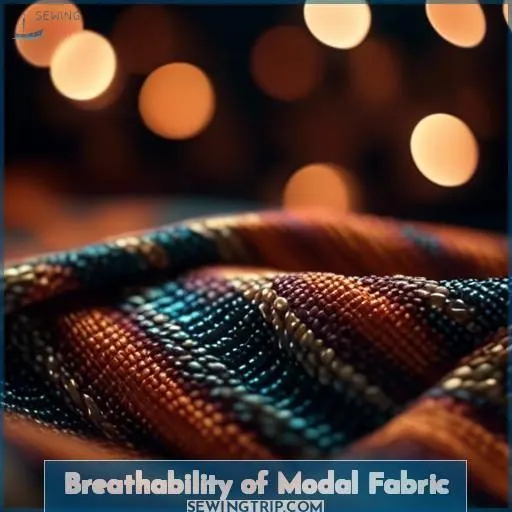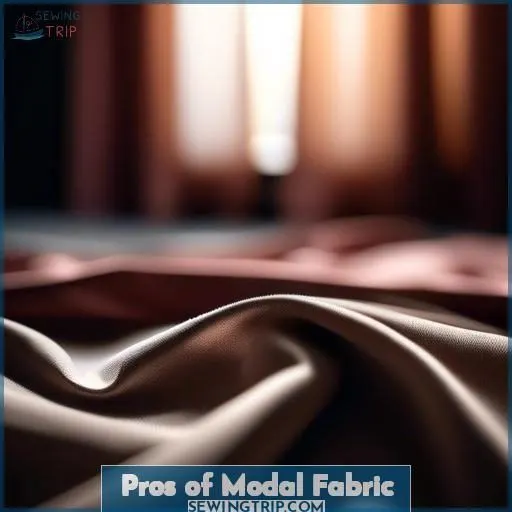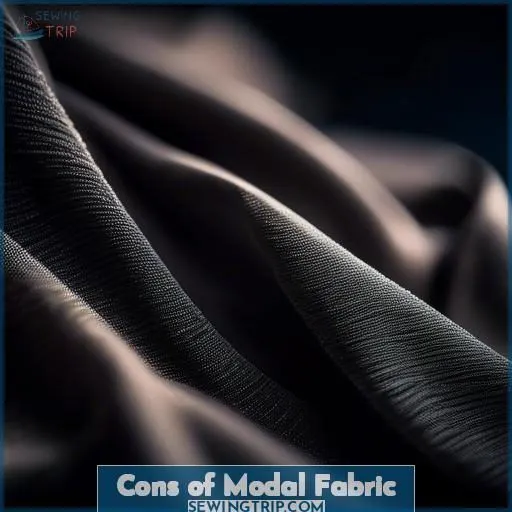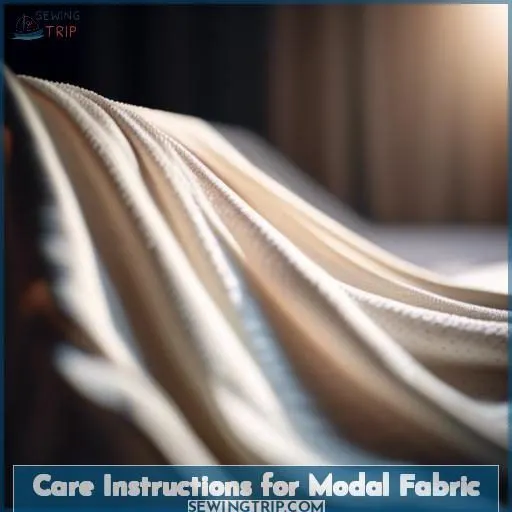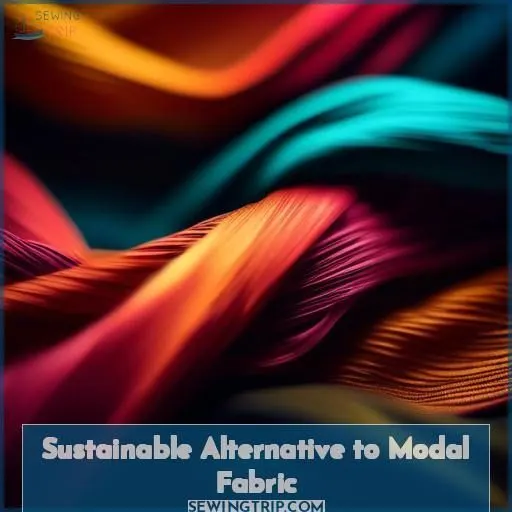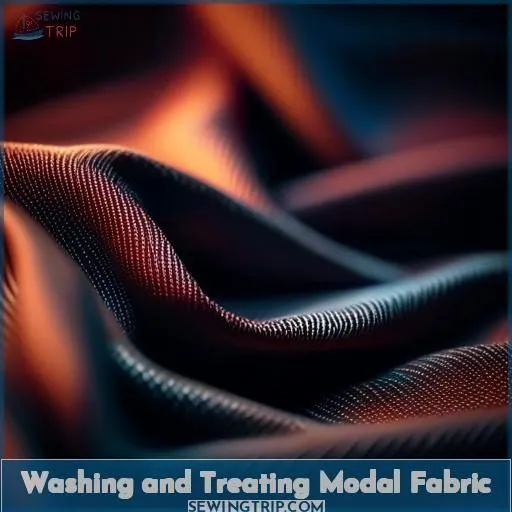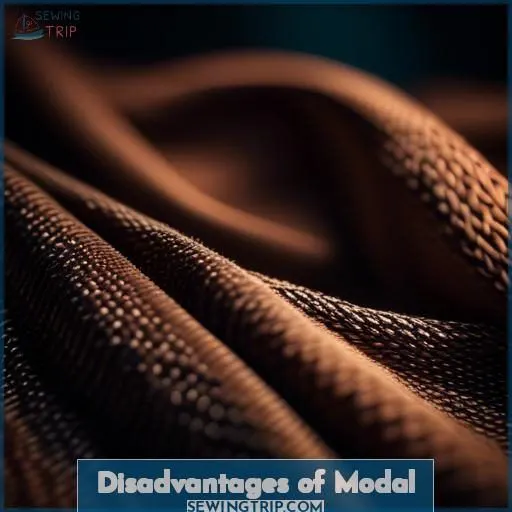This site is supported by our readers. We may earn a commission, at no cost to you, if you purchase through links.
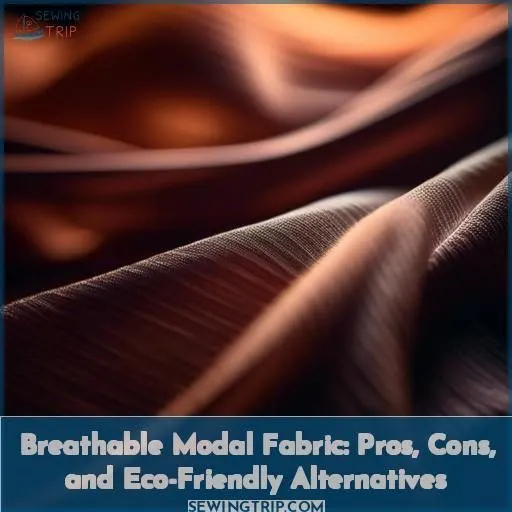
In the realm of airy modal fabric, it’s crucial to ponder both its strengths and weaknesses. Modal is highly breathable, rendering it perfect for sweltering conditions and energetic motion. Additionally, it’s environmentally conscious, water-efficient, and biodegradable, while boasting a silky, plush texture.
However, modal might not surpass cotton in breathability for specific uses like undergarments, and it may present allergy risks or durability issues. Its upkeep can also prove arduous.
To thoroughly grasp the pros and cons of breathable modal fabric, and to delve into sustainable options, continue reading for a more detailed examination of this multifaceted textile.
Table Of Contents
Key Takeaways
- Modal fabric is highly breathable and suitable for hot weather or active movement.
- It has eco-friendly properties, such as being water-efficient and biodegradable.
- However, it may not be as breathable as cotton for certain applications, and it can present allergic reactions or durability issues.
- Sustainable practices in modal fabric production are crucial for minimizing environmental impact.
Breathability of Modal Fabric
Modal fabric is known for its exceptional breathability, which allows better airflow and improved ventilation. It’s particularly suitable for garments worn in hot weather or during active movement, as it keeps the body feeling cool and dry.
However, the breathability of modal fabric can be a concern in certain applications. Some types of modal can be made with different weave types for varying breathability, but cotton is generally more breathable for underwear applications.
Additionally, modal fabric can be made into a tight weave, while cotton is typically woven loosely, contributing to its higher breathability.
Pros of Modal Fabric
You’ll be impressed by modal fabric’s eco-friendly efficiency and water-wise, biodegradable properties. Its silky softness and comfort, coupled with exceptional absorbency and breathability, make it a transformative and versatile fabric choice.
Eco-Friendly Efficiency
As you delve deeper into the realm of modal fabric, it’s imperative to grasp its eco-friendly efficacy. Modal, a semi-synthetic fabric derived from wood pulp, primarily from beech trees, a renewable resource, presents an appealing option for those seeking sustainable choices in the fashion arena. However, modal fabric’s sustainability hinges on responsible farming and manufacturing practices.
Modal’s manufacturing process entails chemical use, which can impact the environment. Nonetheless, certain brands, such as Lenzing, employ eco-friendly bleaching techniques for TENCEL Modal®, thereby minimizing the environmental footprint of the production process. Additionally, modal fabric is biodegradable, reducing landfill accumulation compared to synthetic fabrics.
In terms of sustainability, modal fabric boasts several advantages. It requires less water and irrigation than cotton, enhancing its sustainability and eco-friendliness. It also exhibits a high yield, producing ten times more fabric compared to cotton. Moreover, modal fabric is energy-efficient, necessitating minimal cleaning and whitening agents, and it possesses recyclability.
However, modal fabric’s sustainability isn’t guaranteed. It relies on the farming and manufacturing practices employed, such as sustainable wood sourcing and judicious use of chemicals during production. Brands adhering to sustainable practices, like Lenzing, can guarantee that their modal fabric is produced in an eco-friendly manner.
Water-Wise and Biodegradable
As you investigate the realm of eco-friendly fabrics, you’ll discover that modal fabric excels as a water-conscious and biodegradable option. Here are five reasons why modal fabric is a sustainable choice:
- Water conservation: Modal fabric is widely regarded as a more eco-friendly substitute for cotton because beech trees require minimal water for growth. This translates to a substantially lower water footprint for modal fabric compared to cotton.
- Biodegradability: Modal fabric comprises entirely of cellulose, rendering it biodegradable. Upon reaching the end of its lifespan, modal fabric can be composted, incinerated, or disposed of in a landfill. This contrasts with cotton, which necessitates substantial water and chemical inputs during cultivation and can take up to a century to decompose in a landfill.
- Sustainable forestry: Modal fabric is derived from cellulose obtained from trees that can be sourced from sustainably managed forests. Consequently, modal fabric production doesn’t contribute to deforestation or the devastation of native forests.
- Lower chemical usage: The manufacturing process of modal fabric employs fewer chemicals relative to viscose production. This reduction in artificial chemical usage translates to lower energy requirements and a decrease in toxic waste.
- Ethical manufacturing: Modal fabric can be produced in a more ethical manner than certain other fabrics. For instance, Lenzing, a prominent manufacturer of modal fabric, utilizes eco-friendly bleaching methods for TENCEL Modal®.
Silky Softness and Comfort
Moving from the eco-friendly advantages, let’s delve into the velvety smoothness and opulent comfort modal fabric provides. Its silky feel isn’t just a delight for the skin; it’s a mark of the fabric’s quality. The drape of modal fabric is unmatched, offering a smooth, soft, and wrinkle-resistant experience. Here’s a quick guide on caring for these delicate fabrics:
| Fabric Type | Silky Texture | Care Instructions |
|---|---|---|
| Modal | Yes | Gentle wash |
| Cotton | No | Standard wash |
| Silk | Yes | Dry clean |
Embrace the silky fabric for a touch of everyday indulgence.
Exceptional Absorbency and Breathability
Modal fabric is exceptionally absorbent and breathable, making it perfect for activewear applications. It can absorb up to 50% more moisture than cotton and has moisture-wicking properties. This helps regulate temperature and keeps the body cool and dry.
The production process of modal fabric uses chemicals, which can have environmental impacts. However, reputable manufacturers like Lenzing use eco-friendly methods and sustainably sourced materials. For those concerned about environmental impact, it’s crucial to choose brands that prioritize production transparency and use of sustainable materials.
Transformative Properties and Versatility
Modal fabric is renowned for its transformative properties and versatility, making it a popular choice for various applications. Its eco-friendly efficiency, water-wise and biodegradable nature, and silky softness and comfort contribute to its widespread use.
Modal fabric’s exceptional absorbency and breathability make it an ideal choice for activewear, undergarments, and bed sheets. Additionally, its transformative properties allow it to be easily dyed, requiring less energy and chemicals, and maintain color, shape, and low pilling.
However, it’s essential to take into account the potential cons, such as allergic reactions and sensitivities, durability concerns, sustainability caveats, maintenance challenges, and limited heat retention when choosing modal fabric.
Cons of Modal Fabric
While modal fabric is renowned for its softness and breathability, it’s not without its drawbacks. Some users may experience allergic reactions or sensitivities due to the chemicals used in production, and the fabric’s durability can be a concern, particularly regarding pilling and fading over time.
Allergic Reactions and Sensitivities
Allergic reactions and sensitivities can be a worry regarding wearing modal fabric. Some people may face skin irritation, breathing problems, or other allergic reactions due to the chemical processes used to make modal. These reactions can be caused by the use of chemicals like sodium hydroxide and carbon disulfide during production. It’s necessary to be aware of these potential issues and consider them when choosing modal clothing.
For those with known allergies or sensitivities, it’s critical to choose modal from reliable manufacturers who follow sustainable practices and use eco-friendly bleaching methods, like Lenzing’s TENCEL Modal®. Additionally, it’s suggested to wash new modal clothing before wearing it to remove any leftover chemicals that may cause irritation.
If you’re uncertain about your sensitivity to modal, it’s a good idea to do a patch test by wearing a small piece of the fabric for a short period before investing in a larger purchase. This can help you determine if you’re likely to experience any negative reactions.
Durability Concerns
Regarding durability concerns with modal fabric, here are some essential points to bear in mind:
Modal is generally more durable than cotton due to its finer knit. However, some modal fabrics may discolor with age, especially if exposed to sunlight or harsh chemicals.
Pilling with friction is another concern, as modal can accumulate tiny balls of fiber on its surface.
To address these issues, consider using Tencel fabric from Lenzing, which is a more sustainable alternative to modal and has improved durability.
Additionally, beech wood production challenges can impact the overall durability of the fabric.
Sustainability Caveats
Diving into the sustainability caveats of modal fabric, it’s not all smooth sailing. Despite its green roots, the environmental impact can’t be ignored. Production emissions and chemical hazards lurk beneath its silky surface. Ethical sourcing dodges the bullet of forest destruction, but it’s a tightrope walk. Opting for recycled, Pima, or Egyptian cotton might just be your eco-friendly safety net.
Maintenance Challenges
Modal fabric, a semi-synthetic textile made from beech wood cellulose, offers an array of benefits, including exceptional softness, breathability, and moisture-wicking properties. However, maintaining its quality and longevity requires cautious handling. Here are some maintenance challenges and tips to help you care for your modal clothing:
- Wrinkle prevention: Modal is resistant to wrinkles but can still develop creases, especially after washing. To minimize wrinkles, wash your modal clothes in cold water and avoid excessive heat when drying. Lay items flat to dry or use a low heat setting on your dryer. Iron modal on a medium heat, turning the item inside out to prevent shine.
- Pilling reduction: Modal is prone to pilling, a common issue where small balls of fiber accumulate on the surface of the fabric. To reduce pilling, wash modal clothes inside out and avoid high heat settings. Use a fabric shaver to remove any existing pills.
- Odor resistance: Modal is known for its odor-resistant properties, but it’s still important to clean your clothes regularly. Wash modal items on a gentle cycle using a mild detergent, and consider using oxygen-based bleach for stubborn stains.
- Stretch retention: Modal fabric has excellent stretching ability, which helps maintain a comfortable fit. However, it’s important to avoid over-drying, as this can cause the fibers to shrink and become damaged.
- Colorfastness: Modal retains color well, ensuring vibrant and long-lasting garments. However, it’s still vital to follow the care instructions on your clothing labels to maintain colorfastness.
- Easy-care fabric: Modal is generally low-maintenance and requires basic washing and drying. Always read the care labels on your modal items to ensure you’re following the manufacturer’s recommendations.
Limited Heat Retention
Limited Heat Retention (Cons of Modal Fabric):
- Modal fabric is moisture sensitive, which can affect its temperature regulation properties.
- Layering options are essential when wearing modal, especially in cooler environments.
- A synthetic blend can enhance modal’s heat retention capabilities, making it suitable for high-end fashion and luxury fabrics.
- Although not as breathable as cotton, modal’s moisture-wicking properties can help keep the body cool and dry, making it a popular choice for activewear and undergarments.
- Vibrant colors and excellent dyeing capabilities are benefits of modal that can make it an attractive choice for those seeking a semi-synthetic textile with unique properties.
Care Instructions for Modal Fabric
Modal fabric is a versatile and comfortable material, but it requires specific care to maintain its quality and longevity. Here are some guidelines to help you properly care for your modal clothing:
- Hand Wash or Gentle Machine Wash: Always wash modal fabrics gently to avoid shrinkage and damage. Hand washing or using the gentle cycle on your washing machine is recommended.
- Use Cold Water: Cold water is best for washing modal fabric to prevent shrinkage and color fading.
- Choose Mild Detergent: Use a mild detergent specifically designed for delicate fabrics to avoid damaging the fibers.
- Air Dry: After washing, lay the garments flat on a clean towel or hang them to air dry. Avoid using a dryer, as excessive heat can weaken the fibers and lead to shrinkage.
- Store with Care: Fold modal cotton clothes neatly and store them in a cool, dry place away from direct sunlight to prevent wrinkles and maintain their shape.
- Avoid Hot Water: Hot water can cause modal fabric to shrink and lose its softness.
- Say No to Bleach: Avoid using bleach or harsh detergents containing bleach, as they can damage the fabric’s fibers and lead to discoloration.
- Refrain from Using a Dryer: The high heat of a dryer can damage modal fabric and lead to shrinkage.
- Avoid Direct Sunlight: Prolonged exposure to direct sunlight can cause fading and weaken the fabric.
To help you remember these care instructions, we’ve created a table summarizing the key points:
| Care Instruction | Description |
|---|---|
| Hand Wash or Gentle Machine Wash | Opt for gentle washing methods to avoid shrinkage and damage. |
| Use Cold Water | Wash in cold water to prevent shrinkage and color fading. |
| Choose Mild Detergent | Use a mild detergent specifically designed for delicate fabrics. |
| Air Dry | Lay flat or hang to air dry after washing. |
| Store with Care | Fold and store in a cool, dry place away from direct sunlight. |
| Avoid Hot Water | Stick to cold or lukewarm water for washing. |
| Say No to Bleach | Avoid bleach or harsh detergents containing bleach. |
| Refrain from Using a Dryer | The high heat of a dryer can damage modal fabric and lead to shrinkage. |
| Avoid Direct Sunlight | Prolonged exposure to direct sunlight can cause fading and weaken the fabric. |
Sustainable Alternative to Modal Fabric
When contemplating a sustainable alternative to modal fabric, it’s imperative to seek out brands that prioritize eco-friendly practices throughout their supply chain. Some of the most sustainable modal clothing brands include Patagonia, ARMEDANGELS, and Tentree, which reduce their carbon footprint, employ full traceability, and aspire towards circularity. These brands guarantee that their modal fabric is produced in a closed-loop system, which recovers and reuses liquids and chemicals, making the process more sustainable.
An additional eco-friendly alternative to modal fabric is TENCEL™ Modal, which is made in closed-loop systems that recover and reuse liquids and chemicals, minimizing the release of harmful substances into the environment. This fabric is also made from sustainably sourced wood pulp, ensuring that the raw materials are renewable and responsibly sourced.
When selecting a sustainable alternative to modal fabric, it’s critical to seek out brands that are transparent about their manufacturing processes and prioritize eco-friendly practices. By doing so, you can make informed choices that align with your environmental values and contribute to a more sustainable fashion industry.
Washing and Treating Modal Fabric
Moving from investigating eco-friendly options, let’s delve into the details of maintaining your modal fabric in pristine condition. Caring for modal isn’t an arduous task, but it requires some knowledge to guarantee its freshness. Here’s a quick guide:
- Stain Removal: Respond promptly with cold water and mild detergent.
- Odor Resistance: Ventilate promptly to preserve its freshness.
- Fade Prevention: Wash inside out in cold water.
- Static Mitigation and Ironing Techniques: Low heat is your ally, both in the dryer and while ironing.
Advantages of Modal
Modal production offers several advantages. It uses considerably less water than cotton production and can be made from sustainably managed beech wood forests. The fabric is also biodegradable, making it a more sustainable choice.
Modal’s silky softness and comfort are unparalleled, providing a luxurious feel that many other fabrics can’t match. Additionally, modal is exceptionally absorbent and breathable, making it ideal for activewear and undergarments.
It’s also transformative, as it can be easily dyed with less energy and chemicals, and maintains color, shape, and low pilling. Ethical manufacturing and a reduced environmental impact are other benefits of modal, making it a smart choice for those conscious of their carbon footprint.
Disadvantages of Modal
Modal’s durability is a pro, but its price can be a con for some. While modal is soft and silky, it may not be as soft as cotton right off the bat. The environmental impact of modal production is a concern, as it involves the use of chemicals and a process that can be harmful to the environment. Additionally, while modal is generally more breathable than cotton, it may not be as breathable as some other fabrics.
Frequently Asked Questions (FAQs)
Is modal fabric more breathable than cotton?
Generally, modal fabrics aren’t as breathable as cotton. While modal boasts moisture-wicking abilities, its tightly-woven construction can restrict airflow. For best breathability, cotton is usually the better choice, especially for warm-weather garments like undergarments.
What is the manufacturing process of modal fabric?
The modal fabric manufacturing process starts with harvesting beech trees, extracting cellulose fibers, and chemically processing them into a silky, durable fabric. It’s a bit intense, but the end result is quite luxurious, don’t you think?
How does the sustainability of modal fabric compare to cotton?
You’ll be glad to hear that modal is generally more sustainable than cotton. While cotton gulps down tons of water and chemicals, modal’s wood-based production has a lighter eco-footprint. So, you can feel good about modal’s green credentials.
What are the care instructions for modal fabric?
You’ll want to machine wash modal in cold water and tumble dry on low heat. Use a gentle detergent and avoid bleach or fabric softeners to keep your modal silky smooth for years to come.
What are the advantages and disadvantages of modal fabric compared to other fabrics?
Modal fabric is like a chameleon – it’s soft as silk, durable as steel, and wicks moisture better than a sponge. But it can wrinkle more than a troubled mind. The choice is yours – the pros outweigh the cons.
Conclusion
Ultimately, breathable modal fabric offers a compelling blend of benefits and drawbacks. While it excels in eco-friendliness, softness, and breathability, it also has potential drawbacks such as allergic reactions, durability issues, and maintenance challenges.
To make an informed decision, carefully consider your specific needs and explore sustainable alternatives that may better suit your preferences. By understanding the pros and cons of breathable modal fabric, you can make a well-rounded choice that aligns with your priorities.

